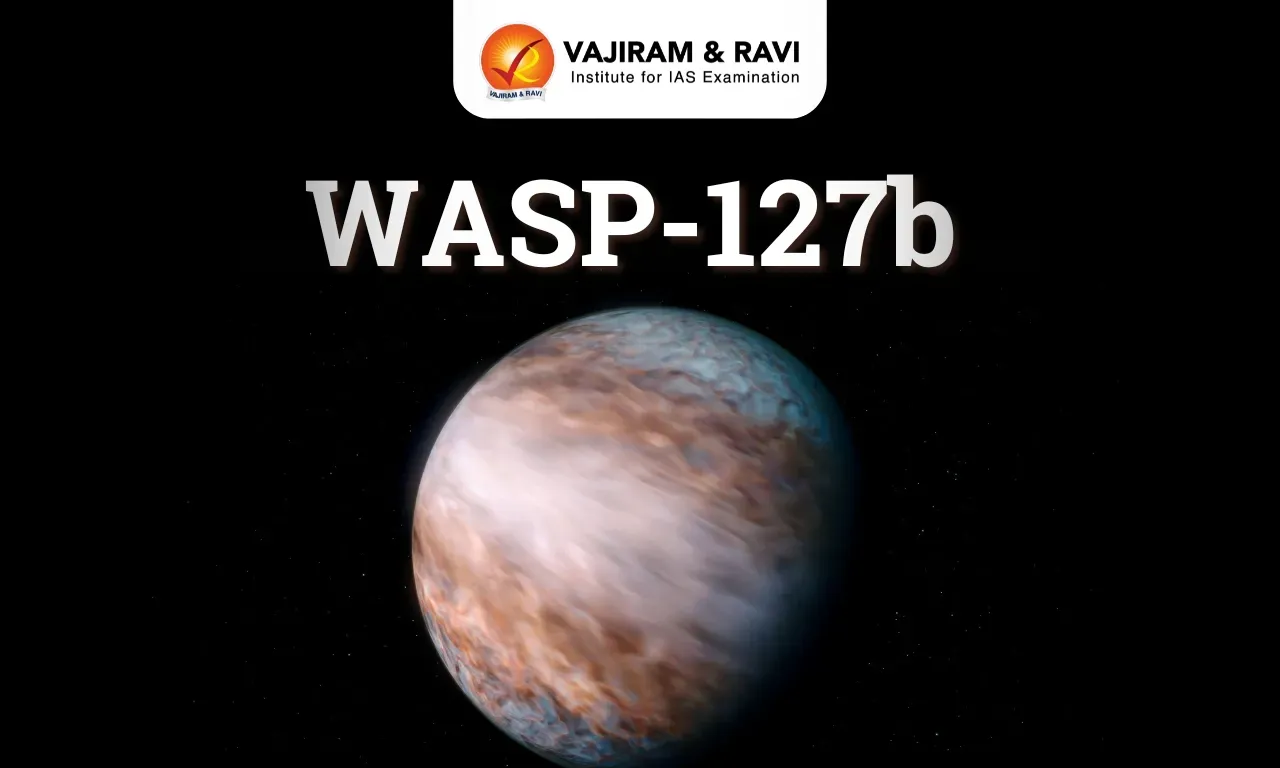WASP-127b Latest News
Scientists recently detected ‘supersonic winds’ travelling at a speed of 33,000 km per hour on a giant gaseous planet named WASP-127b.
About WASP-127b
- It is a large gaseous exoplanet, located in our Milky Way galaxy.
- It is approximately 520 light-years from the earth in a tight orbit around a star similar to our sun.
- It is a type called a hot Jupiter, a gas giant that orbits very close to its host star.
- It orbits its star roughly every four days at just about 5% of the distance between the earth and the sun, leaving it scorched by stellar radiation.
- Like our moon is to the earth, one side of WASP-127b perpetually faces its star—the day side. The other side always faces away—the night side.
- Its atmosphere is about 2,060 degrees Fahrenheit (1,400 degrees Kelvin/1,127 degrees Celsius), with its polar regions less hot than the rest.
- WASP-127b’s diameter is about 30% larger than Jupiter’s, but its mass is only about 16% that of Jupiter’s, making it one of the puffiest planets ever observed.
- Like Jupiter, WASP-127b is composed mainly of hydrogen and helium, but its atmosphere also contains traces of more complex molecules such as carbon monoxide and water.
- WASP-127b is a gas giant planet, which means that it has no rocky or solid surface beneath its atmospheric layers.
- Instead, below the observed atmosphere lies gas that becomes denser and more pressurized the deeper one goes into the planet.
- The supersonic jet stream winds circling WASP-127b at its equator are the fastest of their kind on any known planet.
WASP-127b FAQs
Q1. When was WASP-127b discovered?
Ans. WASP-127b was discovered in 2016.
Q2. Why are planets named WASP?
Ans. Exoplanets named after astronomical or planet-searching projects include the HAT planets (after the Hungarian Automated Telescope Network (HATNet)), and the WASP planets (after the SuperWASP project), both of which are ground-based efforts.
Q3. How old is the Milky Way?
Ans. Our universe is about 13.8 billion years old, so most galaxies formed when the universe was quite young. Astronomers believe that our own Milky Way galaxy is approximately 13.6 billion years old.
Source: N18
Last updated on December, 2025
→ Check out the latest UPSC Syllabus 2026 here.
→ Join Vajiram & Ravi’s Interview Guidance Programme for expert help to crack your final UPSC stage.
→ UPSC Mains Result 2025 is now out.
→ UPSC Notification 2026 is scheduled to be released on January 14, 2026.
→ UPSC Calendar 2026 is released on 15th May, 2025.
→ The UPSC Vacancy 2025 were released 1129, out of which 979 were for UPSC CSE and remaining 150 are for UPSC IFoS.
→ UPSC Prelims 2026 will be conducted on 24th May, 2026 & UPSC Mains 2026 will be conducted on 21st August 2026.
→ The UPSC Selection Process is of 3 stages-Prelims, Mains and Interview.
→ UPSC Result 2024 is released with latest UPSC Marksheet 2024. Check Now!
→ UPSC Prelims Result 2025 is out now for the CSE held on 25 May 2025.
→ UPSC Toppers List 2024 is released now. Shakti Dubey is UPSC AIR 1 2024 Topper.
→ UPSC Prelims Question Paper 2025 and Unofficial Prelims Answer Key 2025 are available now.
→ UPSC Mains Question Paper 2025 is out for Essay, GS 1, 2, 3 & GS 4.
→ UPSC Mains Indian Language Question Paper 2025 is now out.
→ UPSC Mains Optional Question Paper 2025 is now out.
→ Also check Best IAS Coaching in Delhi

















